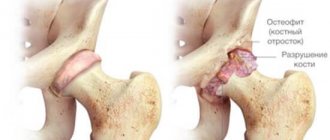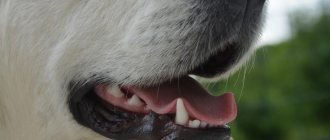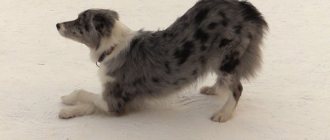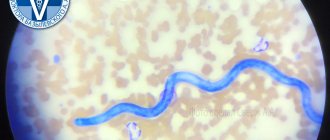What is kennel cough in dogs?
We should start with the fact that kennel, or kennel (sometimes there are also other modifications of the definition, for example, kennel, kennel) cough in a dog is a popular, not a scientific name. Veterinary science uses an official term that describes this condition as infectious laryngotracheobronchitis. In certain cases, depending on the localization of the infectious agent in the upper respiratory tract of the animal (larynx, trachea, bronchi), shorter names are used - tracheobronchitis or laryngotracheitis.
Important! Laryngitis, tracheitis and bronchitis, according to generally accepted terminology, mean acute respiratory infection of the respiratory tract, but in the first case we are talking about damage to the mucous membranes of the larynx, in the second the pathogen is concentrated in the trachea, i.e. between the bronchi and larynx, in the third
-
the pathogen descends into the bronchi.
The next fundamental point that you should know is that aviary cough is not a disease, but a syndrome, i.e. a complex of certain clinical signs, including:
- external manifestation - damage to the upper respiratory tract;
- the form of the course is always acute;
- type of condition - inflammatory;
- nature of occurrence - external source, infection (viral, bacterial, parasitic or mixed).
Depending on which microorganism became the source of kennel cough in a dog, infectious laryngotracheobronchitis syndrome can occur, for example, with the following types of diseases:
| Name of the disease | Pathogen |
| Adenovirus | Respiratory adenovirus type CAV-2 is a DNA-containing adenovirus type II from the genus Mastadenovirus |
| Bordelliosis | Gram-negative aerobic bacteria Bordetella bronchiseptica |
| Parainfluenza | Paramyxovirus family virus, strain CPIV |
| Canine flu | A special strain of the H3N8 influenza virus |
| Herpes virus infection | DNA virus of the Herpesviridae family |
| Reovirosis | Virus of the Rheoviridae family (with a double strand of DNA, without an envelope, the closest “relative” of orbiviruses and rotaviruses |
| Chlamydia | Obligate intracellular parasites Clamidia abortus and Clamidia psittaci |
| Mycoplasmosis | Prokaryotic parasites from the class Mollicutes |
| Rickettsial disease | Rod-shaped bipolar bacteria Ehrlichia canis, belonging to the species Neorickettsia helminthoeca |
But in the vast majority of cases, kennel cough is still explained by infection of the animal with the parainfluenza virus CPiV-2, often burdened by the bacterial infection Bordetella bronchiseptica (Bb).
Did you know? In 2004
–
2005 A real epidemic of canine flu swept the United States, and the mortality rate among infected animals reached 10%. Like any flu, the H3N8 virus mutates very easily and is therefore difficult to localize, but, fortunately, this strain is only dangerous for dogs and is not transmitted to humans.
Routes of infection
Kennel cough in dogs is a viral disease. It can easily be transmitted by airborne droplets from a sick animal to a healthy one. Just a few seconds of direct contact are enough.
This is why cough is called kennel or aviary cough, because it instantly spreads among animals that are close to each other.
You are most likely to catch an infection in places where there are large concentrations of dogs. And these are kennels, animal shelters, clubs, dog shows and veterinary clinics. Yes, if you go to a veterinary clinic with any other problem, your pet runs the risk of additionally contracting kennel cough if a sick animal is near you.
The source of infection can be either direct contact or remnants of saliva from an infected animal.
Absolutely any four-legged animal can become infected. But young puppies, older dogs and animals with weakened immune systems are especially susceptible to infection.
Due to the structural features of the jaw apparatus, dog breeds such as bulldogs and pugs suffer the disease much more severely.
In confined spaces, the infection spreads faster.
How can a dog become infected?
Speaking about the routes of infection with infectious laryngotracheobronchitis, it is appropriate to return to why this acute respiratory syndrome was called kennel cough. This is not at all about the fact that the disease affects only animals kept in enclosures, that is, in the fresh air. On the contrary, such dogs, with proper care and good feeding, usually have much stronger immunity to colds than their “apartment” counterparts. Simply, like all viral infections, infectious laryngotracheobronchitis is very contagious.
It is easily transmitted from one animal to another both by contact and by airborne droplets. Therefore, if in a place where a large number of dogs gather (in a yard, at an exhibition, in a veterinary clinic) at least one is infected, with a high degree of probability, cough will soon appear in all other individuals or most of them, and with constant contact of animals with each other with a friend, for example, within the same enclosure or apartment, “widespread” infection is almost inevitable.
Important! The causative agent of kennel cough can be excreted in saliva, urine, feces, and sweat, after which it can remain viable on dog bedding, dishes, collars, and other objects for quite a long time.
Outdoors, the likelihood of infection is much lower than indoors. This is due to the fact that the aerosol form of the pathogen (a virus contained in a dispersed suspension of small water particles that are released into the air with the breathing, coughing or sneezing of an affected individual) in a closed environment is capable of maintaining a high concentration, while the movement of air masses dispels it almost instantly. In addition, the survivability of the virus in open space is very low - a large supply of oxygen destroys the protein structure of the parasite and, in addition to this, severely dehydrates it.
You should also know that each viral infection has its own characteristics, including the period during which a sick animal is able to infect others. In some cases, a dog that continues to cough no longer poses a danger to its fellow dogs, but it also happens the other way around - the symptoms of the infection have not yet appeared, but infection occurs.
Did you know? In 2003, the world was gripped by an outbreak of coronavirus infection SARS-CoV, better known as SARS. Its mortality rate was 10%, i.e. it was much higher than that of COVID-19, but it manifested itself immediately and became infectious after a few days, while the Chinese coronavirus 2021 behaves in exactly the opposite way.
Another way of infection, besides direct contact with a sick animal, is the introduction of the virus on a person’s clothes, shoes, hair and hands. This is why veterinarians, dog shelter workers and other people who come into contact with a large number of different animals every day should change clothes after returning home and wash their hands thoroughly before responding to the joyful advances of their pet.
What are the causes of the disease kennel cough?
Aviary cough is caused by the canine parainfluenza virus . But this virus does not pose any danger to human health.
.
Often the course of the disease is from fourteen to twenty days, but there is a small nuance that must be taken into account: even when the dog has completely recovered from the infection, it can be a carrier of the pathogen
for at least six, or even all sixteen weeks. This nuance should be taken into account if you are the owner of two or more dogs, or if you are involved in breeding animals.
How to recognize infectious kennel cough in dogs
- Symptomsdiseases of aviary cough are as follows:
- severe, spasmodic cough is one of the most pronounced symptoms of the disease in principle;
- a slight increase in the animal’s body temperature;
- heavy and hoarse breathing of the dog;
- separation of large volumes of sputum;
- the mucous membranes have a pale appearance, or acquire a slightly bluish tint, this is explained by the fact that oxygen exchange is disrupted.
- Profuse and painful vomiting may also occur.
- loss of interest in food;
- decreased activity;
- malfunction of the digestive system;
- diarrhea.
In the same case, if the animal tolerates the disease quite easily, or if the course of the disease itself is not severe, then the animal may not experience any special deviations from the usual, normal state. The only thing the owner can notice
dogs, it’s that his pet
developed a cough and thirst became somewhat higher than usual.
Therefore, always remember: if you suddenly notice a sharp deterioration in your pet’s physical condition, you should immediately seek advice from a veterinarian. And if you don’t have time to take your animal to the veterinary clinic yourself, standing in traffic jams and silently watching the treasured time slip through your fingers, then know that a solution has been found - our veterinary clinic “YA-VET” provides all people who contact us with such a service as calling a veterinarian to your home. Upon arrival at your call, the veterinarian will be able to conduct a thorough examination of your animal, make an accurate diagnosis and prescribe the appropriate treatment. In this case, the veterinarian will provide you with all the necessary licenses and certificates. Our veterinary center also provides an emergency call service to a veterinarian at night.
What to do at the first symptoms of kennel cough
If you notice the first symptoms of infection , the first thing you must do is isolate it as quickly as possible. Why and why do you need to resort to isolating the animal? We answer: because the infection itself is quite contagious
!
In addition, the better the conditions in which the animal is kept (this includes the absence of stress factors and a normal, adjusted level of air humidity in the room), the faster your pet will be able to recover and return to its normal, everyday, healthy physical state. In addition to the above actions, before the veterinarian arrives,
you can relieve your animal’s coughing attacks by resorting to the use of products that contain hydrocodone. But you shouldn’t get carried away with them because such drugs can cause banal addiction in an animal after a short period of time. It is best to use them point-by-point and for severe coughing attacks, thus, as it were, stopping it.
Enclosure cough in dogs is also called differently - canine influenza or infectious tracheobronchitis . Among other things, your dog can become infected with a similar unpleasant disease in places where there are a large number of different animals, for example:
- all kinds of dog shows;
- walks in the park, where owners simultaneously walk their pets;
- in a zoological store;
Without a doubt, not only an adult dog, but also a small puppy can get this disease.
How do the symptoms of the disease manifest themselves?
Depending on the type of pathogen, from the moment the dog is infected until the first symptom of infectious laryngotracheitis appears, it can take from two days to two weeks. The clinical picture of kennel cough is characteristic of all acute respiratory viral diseases.
As a rule, the pet's condition worsens suddenly and is accompanied by:
- attacks of unproductive (dry) cough, sometimes so painful that the dog may have a gag reflex;
- increased body temperature (may be slight, sometimes this symptom is absent altogether);
- enlarged lymph nodes;
- watery nasal discharge;
- redness of the pharynx and larynx.
With a mild form of kennel cough, the dog may maintain a good appetite and almost no change in mood - the animal remains active, plays with pleasure, and does not refuse walks. Apathy, lethargy, and drowsiness usually appear in the evening, although this rule is not absolute. After a few days, the cough gradually moves into the productive stage, that is, it is accompanied by the production of sputum. If the situation develops favorably, the disease goes away in 1–2 weeks.
Important! Seasonality is a characteristic feature of kennel cough. In the Northern Hemisphere, such infections usually flare up in winter, after a decrease in relative humidity.
If the infection is more severe, the symptoms listed above may include purulent discharge from the nose and eyes (conjunctivitis), difficulty breathing with wheezing, persistently high temperature, poor coordination of movements, and a depressed state. If such signs appear, an urgent visit to the veterinarian is necessary.
The main symptoms of tracheobronchitis
It also happens that the dog owner does not notice that the pet is already sick. The fact is that tracheobronchitis is practically asymptomatic. The appetite does not disappear, and the animal looks healthy.
The main indicator of the disease is an uncontrolled dry cough. It occurs due to dry airways. The cough gets worse if you touch the dog in the neck or jaw area.
The incubation period of the disease lasts from 4 days to several weeks. It all depends on the pathogen and the form of the disease:
- Acute form, the disease manifests itself within several days;
- Under acute, the disease progresses slowly and serious complications are possible.
Experts include the following signs as the main symptoms of aviary cough:
- Frequent, convulsive cough without sputum;
- Labored breathing;
- A sharp jump in temperature to 39-40 degrees at the initial stage;
- Copious nasal discharge;
- Tonsillitis;
- Diarrhea or vomiting may occur.
Without proper treatment of a dog with a subacute phase, the case can end in death
.
Diagnosis of the disease
Making the correct diagnosis is already half the success . It is best to consult a veterinarian for this procedure. After all, diagnosing the disease on your own is very difficult. Due to the lack of pronounced symptoms, it is easily confused with similar diseases. For example, due to inflammation of the tonsils, tracheobronchitis is similar in its symptoms to ordinary sore throat, and the symptoms of nausea and vomiting are confused with the plague.
That is why the doctor tries to use detailed data for diagnosis:
- Examination of the animal;
- Studying the history of vaccination;
- Blood and urine tests;
- Hematological studies;
- X-ray, to rule out other potential causes;
- Bronchoscopy in severe cases.
Of course, the selection of diagnostic procedures largely depends on the condition and severity of the disease. Also, it should be taken into account that tracheobronchitis can have several pathogens at once. Thus, the clinical picture is influenced by several factors:
- Age, weight and breed of the dog;
- Availability of vaccinations;
- General health of the patient;
- State of immunity.
Diagnostics
Diagnosis of acute respiratory viral infections usually involves examination and history. The clinical picture for such conditions, as a rule, looks quite clear, and the veterinarian should not have any difficulties with identification. There is no urgent need to determine the specific causative agent of the lesion, since the nature of the care provided to the animal does not depend on this and, in fact, is standard.
Exceptions are situations when severe coughing attacks are caused not by a viral, but by a bacterial microflora, but even in this case, it is only important for the veterinarian to be able to distinguish between these two types of infections, which, fortunately, have certain specific features. A clinical blood test will help make sure that the infection is bacterial in nature (chronic nonspecific tonsillitis and tracheobronchitis, pneumonia, tonsillitis, etc.).
Important! Exudation from the nose is the first sign of a viral infection; in addition, it is characterized by simultaneous manifestation in the form of several symptoms. A bacterial infection almost always occurs as a complication of a viral infection, and not on its own, and in rare cases when this happens, it is localized in a specific area - the bronchi, throat, lungs.
In rare cases, with vague symptoms, infectious laryngotracheobronchitis can be confused with chronic heart failure, which also begins to manifest itself in the form of cough or bronchial asthma, which is not invasive, but autoimmune (allergic) in nature.
Therefore, if the doctor has reasonable doubts about the diagnosis, additional procedures and examinations may be prescribed to clarify it, primarily:
- electrocardiography;
- Ultrasound of the heart;
- microbiological and cytological analysis of sputum;
- various special methods for identifying the pathogen and specific antibodies to it (enzyme-linked immunosorbent assay, fluorescent antibody method, neutralization reactions, diffuse precipitation, indirect or passive hemagglutination, bioassays, etc.) are carried out, in particular, when carnivore plague is suspected.
Treatment
If your four-legged friend's immune system is in excellent condition, the infection should go away on its own without any drug intervention. But to speed up recovery, the animal is prescribed drug therapy.
With timely and well-structured treatment, the symptoms of the disease begin to disappear after 4-5 days of therapy. The pet's condition is returning to normal. But, for greater effectiveness, as a rule, the course of treatment is prescribed for up to 14-20 days.
General rules of therapy
If your pet does get an infection, you should adhere to the following treatment rules:
- If the animal is kept in a kennel or shelter, it should be immediately separated from other dogs. Although, even with short contact with a sick dog, the likelihood of infecting others is very high.
- The domestic eared eared dog must be limited in walks. It is generally better not to take sick puppies outside. Adult dogs go out for walks only to relieve themselves. Cool air irritates inflamed airways, and the disease can progress.
- Provide your shaggy friend with maximum peace. Limit active physical activity.
- The room in which the sleeping place is located must be dry and warm, without drafts. When your pet is away, it needs to be well ventilated.
- To relieve coughing, you can give your furry friend so-called inhalation baths. Open the hot water and wait until the bathroom is filled with steam. Just bring your pet in for 1-2 minutes so that he can breathe warm, moist air. It is best to repeat such procedures 3-4 times a day. Humid air is great for reducing respiratory irritation and thins mucus, making it easier for your dog to cough up phlegm that has accumulated in the throat.
Nutrition during treatment
To quickly remove the infection from the body, the dog needs to drink as much as possible. The water should be clean and at room temperature.
If the animal has no appetite, you should not force feed it. This may trigger a gag reflex.
In addition to inhalations, home remedies that help soothe your throat include:
- Mix a teaspoon of honey and a little lemon juice in warm water. This drink should be offered to your pet every 1-2 hours, literally 1-2 tablespoons.
- Warm milk with honey or low-fat warm meat broth will also perfectly warm and soften the respiratory tract.
Important! You can offer honey only if the dog does not have diabetes or intolerance to this product.
To avoid further irritation of the throat, during illness you should not offer your dog bones or solid food.
If the dog eats dry food, it is recommended to pre-soak it in meat broth.
Drug therapy
There is no standard treatment regimen for kennel cough in dogs. Each doctor prescribes treatment depending on the general condition of the pet and the results of the tests obtained.
Typically, drug treatment includes:
- Prescription of expectorants and antitussives, such as: Mucaltin, Bromhexine, children's Robitussin (1 teaspoon per 10 kg of weight). Children's Pertusin and Licorice Root are also good for removing phlegm. It is recommended to give cough medicine once a day.
- To strengthen the body's immune system, immunomodulators are prescribed. These can be homeopathic remedies such as: Gamavit, Immunofan, Aflubin.
- If after several days of treatment the pet's condition does not improve, the doctor prescribes antibiotics. Sometimes antibiotics are prescribed right away. This is done if a bacterial infection joins the viral one. This can only be determined by scraping for the presence of bacterial microflora. Or if the animal has signs of chest congestion. This could be: veterinary drug Sinulox, human Unidox, Sizomycin.
- If a four-legged animal has problems with the gastrointestinal tract in the form of diarrhea or indigestion, probiotics (Bifidumbacterin) and digestive enzymes (Pancreatin) are prescribed to normalize stool and digestion.
Remember! It is strictly forbidden to use human medications without a doctor's prescription. Many of the drugs that are harmless to humans are deadly to four-legged animals.
As an example, we would like to show the prescription of treatment to our friend Chipik, who was recently cured of kennel cough.
Results of analysis of scrapings of epithelial cells of the nasal mucosa.
Prescribed treatment.
Treatment of kennel cough in dogs
If a dog’s kennel cough is viral in nature, and in most cases it is, the animal does not need any targeted treatment, since the most effective and safe way to quickly cope with this kind of pathogen is the animal’s own immune system.
Did you know? “Coronaviruses” got their name thanks to special processes that actually resemble a crown. It is thanks to these processes that the pathogen penetrates the cell membrane, posing as a completely harmless molecule.
Any drug therapy and other auxiliary measures in this situation can be aimed at eliminating the main symptom of infection - a painful cough. You can do this at home, but before using any drug, the admissibility of such a procedure, the course and dosage must be agreed with a veterinarian.
Drugs
The following categories of medications can be prescribed to a dog as symptomatic medications for kennel cough:
| Drug category | Examples of trade names or medicinal herbs | Operating principle |
| Expectorants (antitussives) | Deeprovide, Ammonium chloride, Antimony trisulphide, Terpinhydrate; from medicinal plants - coltsfoot, thermopsis herb, anise and dill fruits | Promote the rapid removal of mucus (the so-called bronchial secretion) from the respiratory tract |
| Aerogenic corticosteroids | Flixotide | Improves lung function, relieves cough symptoms and prevents bacterial complications |
| Antispasmodics | No-shpa, Baralgin | Relaxes the muscles of the upper respiratory tract, soothes painful attacks of unproductive cough, accompanied by vomiting spasms |
| Immunomodulators | Galavet, Roncoleukin, Betaleikin (Lyophilisate) | Accelerate blood formation processes, increase immunity, have a general strengthening effect |
| Immunoglobulins | Giskan, Vitakan | Participate in the body’s immune defense, helping it cope with pathogens due to the ability to act on antigens in a special way |
If laryngotracheitis has a bacterial component, the disease can only be treated with antibiotics. As a rule, dioxycycline (a common trade name is Unidox-solutab) or azithromycin (Sumamed, Azikan, etc.) are used in this capacity. Only a doctor can prescribe the course of treatment and dosage, but usually antibiotic therapy for cough lasts no more than 5–7 days.
Since viral respiratory infections often lead to bacterial complications, it is very common in general medical and veterinary practice to prescribe a short course of antibiotics to prevent such complications. This approach can be debated, although the position of the World Health Organization is clear: the prophylactic use of antibiotics is unacceptable. Neither in people nor in animals.
Carrying out inhalation
From the point of view of the average person, inhalation is usually understood as one of the methods of folk treatment of colds, when the patient, covered with a towel over a saucepan in which potato peelings are boiled or essential oils dissolved in boiling water, frantically breathes in steam, “warming up the throat.”
Such procedures, of course, are not applicable to dogs (however, it is not recommended for people to experiment either). However, inhalations are still possible in the treatment of some acute diseases, including infectious laryngotracheobronchitis, however, we are talking about a completely different event.
Important! Inhalation is a special method of administering drugs, in which their active substance, located in an aerosol suspension, is applied to the mucous membranes of the upper respiratory tract by atomization (spraying).
The advantage of inhalation over a tablet or injection is that local spraying of the active substance dilutes viscous mucus and, thus, relieves coughing attacks. In addition, by dilating the blood vessels of the upper respiratory tract and filling them with blood, the medicine is absorbed faster and provides a targeted (point) effect.
However, inhalation is a non-standard procedure and, if we are talking about a dog, very difficult to implement. It is difficult to explain to an animal the need to open its mouth and wait until a strange substance is injected onto its throat. Therefore, this method of treatment is used only in cases where, for some reason, alternative forms of using the same drugs are impossible or ineffective.
How to care for your dog during treatment
The first rule of caring for a dog suffering from kennel cough is to limit its contact with other animals by any means in order to avoid further and uncontrolled spread of the infection.
There should be no talk about giving up walks or limiting their duration in case of a mild form of the disease; moreover, cool air enriched with oxygen is directly indicated for viral and even bacterial respiratory diseases. However, you need to choose secluded places for these purposes and warn other owners about the inadmissibility of their pets approaching a sick dog.
During illness, the dog should be fed in moderation, while avoiding fatty, high-calorie foods, which are not only difficult for a weakened body to digest, but also lead, due to intensive digestion, to additional production of internal heat, which is contraindicated at elevated body temperatures. It is also a mistake to try to feed your dog hot infusions, milk with honey and other folk remedies, since increased sweating increases the likelihood of developing dehydration, and this condition is considered the most dangerous consequence of hyperthermia.
Until your dog has fully recovered, it is important to keep him hydrated as much as possible, but keep it at room temperature or slightly warm if the dog is ready to drink it. In addition, it makes sense to make your pet’s main diet more liquid, for example, by replacing regular porridge with rice or buckwheat soup with chicken, veal, rabbit or other lean meats.
Did you know? In the middle of the last century, a large pharmaceutical company introduced a new antibiotic to the market that had not undergone preliminary testing.
As a result of the use of this medicine, more than 100 patients died, which became the reason for the creation of the famous FDA (Food and Drug Administration) organization in the United States.
How can you treat dog flu - aviary cough
When treating kennel cough, antibiotics, vitamins, or immunomodulators are often used. At first, when the animal’s body is significantly weakened, the owner is simply obliged to take responsibility, taking an active part in the rehabilitation process. Firstly, this will, of course, provide the animal with the proper amount of drink, but under no circumstances should you add honey to a sick animal’s drink, especially if you know that your pet suffers from diabetes!
Secondly, you can help your dog by taking him into the bathroom two or four times and opening the hot water tap.
Why is this being done? It's simple: while inhaling warm and moist air, the dog will feel much, much better and lighter. It will literally become easier for her to breathe, and the moist steam will help ensure that the mucus that has stagnated will slowly but surely liquefy. Another advantage of such bath procedures is that steam can reduce the degree of swelling of the animal’s respiratory tract, and this is actually extremely important! Also, do not forget that it is not advisable to leave the animal itself in the bathroom. Follow safety precautions.
If your pet becomes infected with tracheobronchitis at an advanced age
, then in this case vaccination takes place. Our veterinarian will be happy to assist you with this procedure while following all proper instructions. Once your pet has fully recovered, it is important to follow preventive measures for a period of time to avoid recurrence of the disease.
Very often, in a fast pace, we forget to give due attention to our animal. Also, in order not to waste time on a visit to the veterinarian, we self-medicate. But it's so dangerous! Some disease symptoms are similar and can easily be confused with each other! Only an experienced veterinarian is able to make a truly accurate diagnosis, eliminating any unnecessary confusion. Take care of your pets and contact our veterinary center in a timely manner!
Possible complications of infectious laryngotracheitis
The most common complication of infectious laryngotracheitis is the addition of a bacterial component to the viral infection of the upper respiratory tract, which usually begins with kennel cough. Typically, microbes living in a dog’s body do not cause it any particular trouble, and their number is maintained at a safe level by the general immune system. But at the moment when all the protective forces are mobilized to fight the strongest pathogen, which is the virus, an extremely favorable environment arises for microbes, protozoa and other parasites and they begin to multiply uncontrollably.
The mucus that accumulates in the animal’s nose and bronchi helps to speed up this process, especially if, due to a lack of fluid in the body, the consistency of the exudate becomes more viscous or, even worse, it dries out and turns into a crust, clogging the respiratory tract and creating real resort conditions for pathogenic microflora. Bacteria that develop due to inadequate treatment of infectious laryngotracheitis can cause severe forms of otitis, bronchitis or pneumonia, and the dog can actually die from these diseases, especially if the process is left uncontrolled and antibiotics are not used.
Another specific complication that can occur in a dog not due to a general weakening of the body by the virus, but precisely due to spasmodic muscle contraction during a strong dry cough, is prolapse (sagging) or collapse (blocking) of the trachea.
In order to understand the essence of this phenomenon, you need to remember the school anatomy course. The trachea in a dog (as in a person) is a tube consisting of cartilaginous half-rings, between which there is connective tissue - the tracheal membrane. If the tracheal cartilages lose their firmness and elasticity (for example, due to age-related changes), they begin to gradually sag. In this condition, aggravated by coughing attacks, involuntary movements of the membrane can block the lumen of the trachea and the animal begins to choke.
Find out what heart cough is in dogs, why it occurs and how to treat it.
Basic methods of prevention
To prevent your dog from needing emergency veterinary care , every effort must be made to protect it from exposure to pathogens. It is not without reason that aviary cough received its name - it is very contagious and spreads quickly in places where there are large concentrations of animals. Moreover, this applies not only to nurseries, but also to veterinary clinics , exhibitions, etc.
All viruses that cause the pathology in question are transmitted by airborne droplets. Healthy animals become infected from sick animals when they are in the same room with them. Dry air, heat or close quarters only increase the likelihood of infection. In addition, a person can carry pathogens on the palms of their hands if they first stroke an infected animal and then a healthy one. However, people are not full carriers of viruses.
Owners know that it is impossible to completely protect a dog from communicating with other representatives of its species. Therefore, it is important to take care of the development of strong immunity in the animal. Good living conditions, adequate feeding, and vitamin therapy will help your pet always remain healthy. In addition, we must not forget about mandatory vaccination. Regularly take your pet to the doctor to have it vaccinated according to the calendar, and the likelihood of contracting kennel cough will decrease significantly. A standard multivalent vaccine is enough and your pet will be safe. And if you have several dogs, make sure that each of them has vaccinations.
Prevention of aviary disease
The best prevention of kennel cough in dogs is a healthy lifestyle, good care and activities aimed at increasing immunity. To prevent collapse or prolapse of the trachea, a coughing dog should not wear a collar; it is better to replace it with a harness.
This list includes:
- a balanced diet rich in vitamins, minerals, amino acids, high-quality proteins, carbohydrates and (in moderation) fats;
- control the pet’s weight, preventing obesity;
- daily long walks in the fresh air, accompanied by active movements (running, jumping, walking over rough terrain, uphill and downhill);
- protecting the dog, if possible, from negative external factors - stress, hypothermia, chemical poisoning, injuries;
- preventing your pet from coming into contact with infected fellows;
- antiparasitic treatment (anthelmintic drugs, flea and tick repellents, etc.);
- compliance with the vaccination calendar - primary vaccination and revaccination;
- regular visits to the veterinarian for a routine preventative examination, as well as immediate contact with the clinic if any alarming symptoms appear, the nature of which is unknown to the owner.
Symptoms
The following symptoms are characteristic of infectious tracheobronchitis:
- dry cough, as if the pet was choking on something;
- reflex vomiting;
- diarrhea;
- serous discharge from the nose, which gradually becomes mucous and dries out, forming crusts;
- conjunctivitis;
- tonsillitis, swallowing is painful, there is a threat of inflammation spreading to the lung tissue.
Sometimes the pet feels well, however, he is tormented by coughing attacks. If your dog has a collar, replace it with a harness during treatment to avoid irritating his throat. The cough continues for 10 days, after which the dog recovers or develops pneumonia.
Description
Enclosure cough in scientific terminology is known as infectious tracheobronchitis. But most often it is called dog flu. In veterinary circles, another name may be used for the infection – adenovirus. With this disease, the upper respiratory tract is inflamed, affected by the parainfluenza virus (less commonly, adenovirus or mycoplasma).
Healthy and strong dogs tolerate pathology quite easily, and cases of independent recovery are not uncommon. But for puppies, young animals and weakened dogs, the consequence of the disease can be bronchopneumonia or chronic bronchitis. This infection is called “kennel cough” because in places where dogs live in large numbers, it spreads very quickly, affecting all individuals without exception. In closed spaces, pathogens spread within a few days.
You can catch the infection not only in closed spaces (aviary, clinic, exhibition center), but also through short-term accidental contact with a sick animal. The virus is transmitted from a sick animal: microbes can be transported along with dust particles or in microscopic air bubbles invisible to the eye. Dogs with strong immune systems can easily withstand exposure to bacteria and become resistant to infection.









